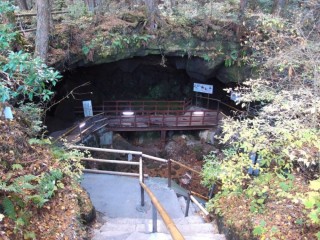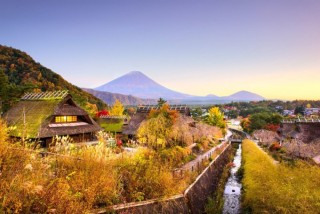Loading
Search
▼ Lake Saiko
- Category:Nature
In and around this lake, you can see Mount Fuji, visit a thatched-roof village, explore three lava caves, and hike the Jukai Nature Trail.
Saiko is one of the Fuji Five Lakes: bodies of water formed by ancient volcanic activity on Mount Fuji’s northern side in Yamanashi prefecture. Past eruptions also helped form three lava caves—where visitors don miner’s helmets—and a beautiful, unearthly forest off the lake’s western shore. The forest, Aokigahara Jukai, is mired in unfortunate associations as a suicide spot, but it also has a nature trail that bridges the distance between caves.
The Nenba district holds a craft village with scenic thatched-roof houses. Around much of the lake, the sight of Mount Fuji is obstructed by other mountains, so you’ll want to know where to go to get the best Fuji view.
Bus stop #67 on Fujikyu’s Green Line Saiko Sightseeing Bus unloads near the minshuku (traditional guesthouses) in the Nenba district. From there, it is a short walk to the westernmost tip of the lake, where you can get the best view of Fuji across the water.
The next stop on the bus is Saiko Iyashi no Sato (“Healing Village”) Nenba. If you cannot make it all the way to Shirakawa-go, this thatched-roof village might be the next best thing. Each farmhouse is devoted to a different craft, with workshops available. This is where handmade soba gets personal. In the winter, you can drink amazake (a traditional sweet drink made from fermented rice) over a sunken hearth.
With low-ceilinged tunnels and ropy lava floors, the Saiko Bat Cave is the biggest of the three caves. Preservation efforts are underway to restore the cave’s bat colony, leaving it closed every year, from Dec. 1 to March 19.
At the cave’s information center, visitors can arrange to have a guided nature tour of Aokigahara Jukai, the “Sea of Trees.” Across the parking lot is the entrance to the Jukai Nature Trail. The other two caves are on the opposite side of the forest.
Descending into Fugaku Wind Cave, you will move past a reservoir where ice is illuminated. The long cave wall even features a natural lava shelf. Beyond that is a natural refrigerator where tree seeds and silkworm cocoons are stored. Narusawa Ice Cave is smaller and geared more toward its namesake. A ladder takes you down to a natural freezer where stacks of ice line both sides of the cave. The course is short but requires you to squeeze through a tight space on a slippery floorboard.
Speaking of ice, it also makes an annual appearance above ground as part of the Lake Saiko Ice Festival.
This wintery event is held in late-January through early-February at the Saiko Wild Bird Forest Park. Visitors can marvel at ice sculptures and 10-meter-high frost-covered trees known as juhyou. These are illuminated after sunset to beautiful effect. The timing of the festival also coincides with weekend fireworks displays at nearby Lake Kawaguchiko for an extra festive experience!
Japan, 〒401-0332 Yamanashi-ken, Minamitsuru-gun, Fujikawaguchiko-machi, Saiko, 県道710号線
Ride the Saiko Sightseeing Bus (Green Line) from Kawaguchiko station. It takes about 30 minutes. If you are visiting the area for more than one day, it is recommended to buy a two-days ticket for ¥1,200.
- Winter fun at the annual Lake Saiko Ice Festival at Saiko Yacho no Mori Park from from Jan. 26 to Feb. 17, 2019.
Saiko is one of the Fuji Five Lakes: bodies of water formed by ancient volcanic activity on Mount Fuji’s northern side in Yamanashi prefecture. Past eruptions also helped form three lava caves—where visitors don miner’s helmets—and a beautiful, unearthly forest off the lake’s western shore. The forest, Aokigahara Jukai, is mired in unfortunate associations as a suicide spot, but it also has a nature trail that bridges the distance between caves.
The Nenba district holds a craft village with scenic thatched-roof houses. Around much of the lake, the sight of Mount Fuji is obstructed by other mountains, so you’ll want to know where to go to get the best Fuji view.
Nenba and the Saiko Healing Village
Bus stop #67 on Fujikyu’s Green Line Saiko Sightseeing Bus unloads near the minshuku (traditional guesthouses) in the Nenba district. From there, it is a short walk to the westernmost tip of the lake, where you can get the best view of Fuji across the water.
The next stop on the bus is Saiko Iyashi no Sato (“Healing Village”) Nenba. If you cannot make it all the way to Shirakawa-go, this thatched-roof village might be the next best thing. Each farmhouse is devoted to a different craft, with workshops available. This is where handmade soba gets personal. In the winter, you can drink amazake (a traditional sweet drink made from fermented rice) over a sunken hearth.
Saiko Bat Cave and Jukai Nature Trail
With low-ceilinged tunnels and ropy lava floors, the Saiko Bat Cave is the biggest of the three caves. Preservation efforts are underway to restore the cave’s bat colony, leaving it closed every year, from Dec. 1 to March 19.
At the cave’s information center, visitors can arrange to have a guided nature tour of Aokigahara Jukai, the “Sea of Trees.” Across the parking lot is the entrance to the Jukai Nature Trail. The other two caves are on the opposite side of the forest.
Wind and ice caves
Descending into Fugaku Wind Cave, you will move past a reservoir where ice is illuminated. The long cave wall even features a natural lava shelf. Beyond that is a natural refrigerator where tree seeds and silkworm cocoons are stored. Narusawa Ice Cave is smaller and geared more toward its namesake. A ladder takes you down to a natural freezer where stacks of ice line both sides of the cave. The course is short but requires you to squeeze through a tight space on a slippery floorboard.
Winter festival
Speaking of ice, it also makes an annual appearance above ground as part of the Lake Saiko Ice Festival.
This wintery event is held in late-January through early-February at the Saiko Wild Bird Forest Park. Visitors can marvel at ice sculptures and 10-meter-high frost-covered trees known as juhyou. These are illuminated after sunset to beautiful effect. The timing of the festival also coincides with weekend fireworks displays at nearby Lake Kawaguchiko for an extra festive experience!
How To Get There
Address
Japan, 〒401-0332 Yamanashi-ken, Minamitsuru-gun, Fujikawaguchiko-machi, Saiko, 県道710号線
Ride the Saiko Sightseeing Bus (Green Line) from Kawaguchiko station. It takes about 30 minutes. If you are visiting the area for more than one day, it is recommended to buy a two-days ticket for ¥1,200.
- January 16, 2019
- Comment (2)
- Trackback(0)
Comment(s) Write comment
amoxil for sale online - <a href="https://combamoxi.com/">order amoxil without prescription</a> cheap amoxil pill
-
xetgr
- July 7, 2025





Thanks on sharing. It’s first quality. https://proisotrepl.com/product/colchicine/
Conniereugs Web Site- July 29, 2025